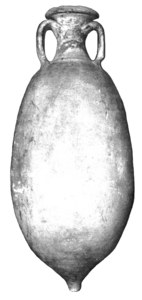Roman Amphorae: a digital resource
University of Southampton, 2005. (updated 2014) https://doi.org/10.5284/1028192. How to cite using this DOI
Data copyright © University of Southampton unless otherwise stated
This work is licensed under the ADS Terms of Use and Access.
Primary contact
Dr
David
Williams
Dept of Archaeology
University of Southampton
Avenue Campus
Highfield
Southampton
SO17 1BJ
England
Tel: 080 593032
Resource identifiers
- ADS Collection: 463
- DOI:https://doi.org/10.5284/1028192
- How to cite using this DOI
Dressel 9 & 10 similis - Lyon

Courtesy of Romermuseum Augst
David Peacock
|
Up to
[Forlimpopoli]
| ||
Distinctive FeaturesThese two forms are based on familiar Spanish prototypes Dressel 9 and Dressel 10 respectively: The earlier Lyon Type 3A has a rim with a pronounced projection while Type 3B, which succeeded 3A, has a distinctive funnel rim. Both have ovoid bodies and hollow spikes (Desbat, 2003).See characteristics | ||
Date RangeType 3A first appears in the Augustan period and was succeeded by 3B in the second half of the first century AD (Desbat, 2003).Search: [1st century BC] [1st century AD] | ||
OriginLyon. Type 3A was made at the workshop of La Muette (Desbat, 1987; 2003). Chemical analysis has shown that both types have a local source (Becker, 1986).Search: [France] [North West Europe] | ||
DistributionFrance and Switzerland: Lyon, Augst, Vidy, Avenches, Neuss (Desbat, 2003).Search: [France] [North West Europe] [Switzerland] | ||
ContentsSeveral examples have tituli picti which list the contents as gari flos, muria hispana and garum hispanum (Martin-Kilcher, 1990).Search: [Fish Sauce] | ||
CommentsPrincipal contributor: David Williams | ||
ClassificationDressel 10 similisDressel 9 similis Lyon 3A Lyon 3B | ||
CEIPAC linkThe following link will take you to the Centro para el Estudio de la Interdependencia Provincial en la Antiguedad Clásica CEIPAC database. In the CEIPAC system this amphora has the ID KE51+BYZ. Note: access to CEIPAC requires registration, which is possible via http://ceipac.ub.edu/corpus_reg.php?IDM=e | ||
Terres dâAmphoresTerres dâAmphoresThe above link will take you to the new digital database of amphora types and fabrics from Gaulish production centres, 1st - 3rd century A.D. (Maison Archéologie & Ethnologie, René-Ginouvès). | ||



 3D models
3D models


